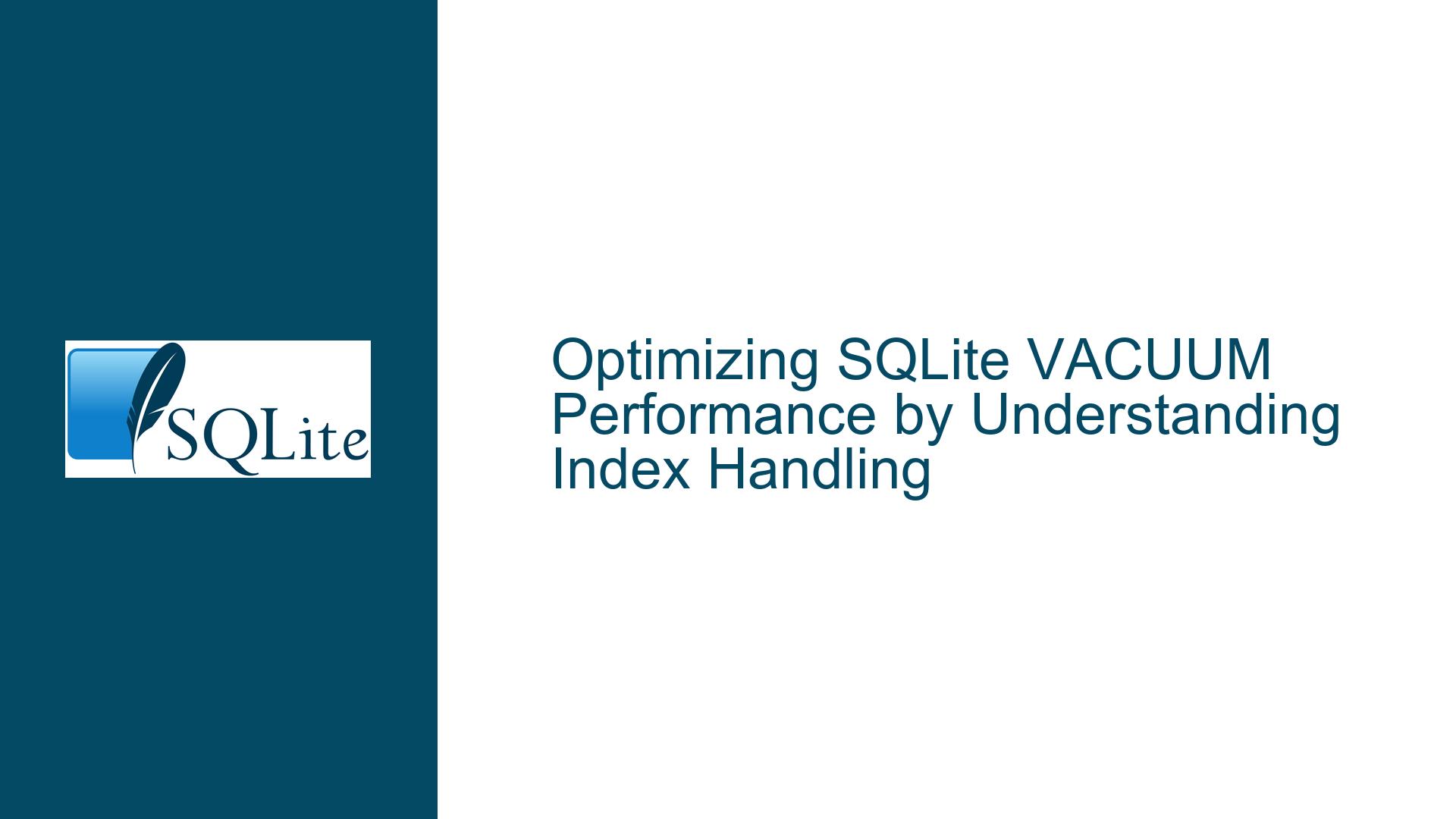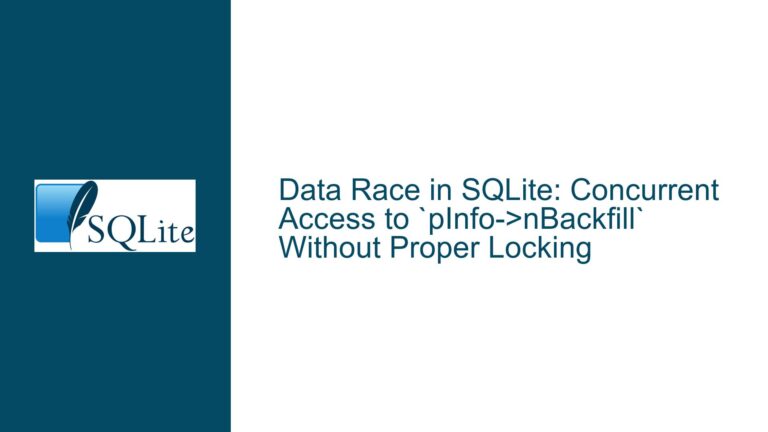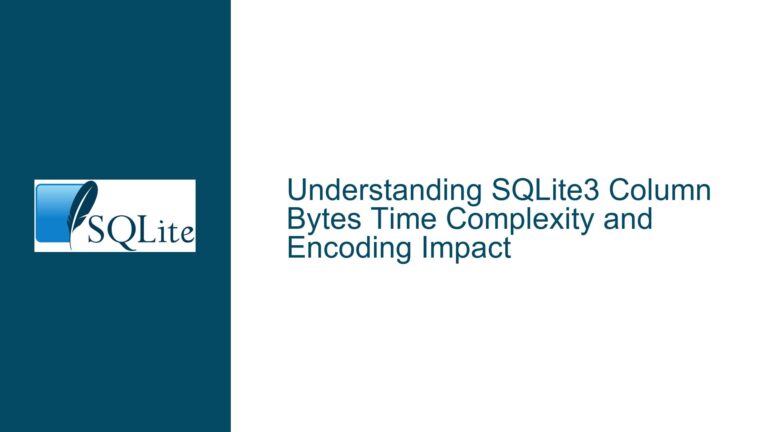Optimizing SQLite VACUUM Performance by Understanding Index Handling
SQLite VACUUM Operation and Index Reconstruction
The SQLite VACUUM operation is a critical maintenance task that rebuilds the database file, repacking it into a minimal amount of disk space. This process involves creating a new database file and copying the contents of the old database into the new one. During this operation, the schema of the original database, including tables and indexes, is replicated in the new database. The VACUUM operation is often used to reclaim unused space, defragment the database file, and improve overall performance.
One of the key steps in the VACUUM operation is the reconstruction of the database schema. This involves querying the sqlite_schema table to retrieve the SQL statements used to create the tables and indexes in the original database. These statements are then executed in the new database to recreate the schema. The process of reconstructing the schema is crucial because it ensures that the new database has the same structure as the original, including all constraints, triggers, and indexes.
However, the way indexes are handled during the VACUUM operation can have a significant impact on the performance of the operation. In particular, the timing of index creation—whether indexes are created before or after data is copied—can affect the speed of the VACUUM operation. This is because creating indexes on an empty table is generally faster than creating indexes on a table that already contains data. This is due to the fact that when indexes are created on an empty table, SQLite can optimize the index creation process by copying the index data directly from the old database to the new one, rather than recomputing the indexes from scratch.
Index Creation Timing and Its Impact on VACUUM Performance
The timing of index creation during the VACUUM operation is a critical factor that can influence the overall performance of the operation. When indexes are created before data is copied, SQLite can take advantage of a special optimization that allows it to copy the index data directly from the old database to the new one. This optimization is possible because the new database is initially empty, and the schema of the new database matches that of the old database. As a result, SQLite can perform a direct copy of the index data, which is much faster than recomputing the indexes from scratch.
This optimization is similar to the one used in the INSERT INTO ... SELECT statement, where SQLite can copy data directly from one table to another if certain conditions are met. Specifically, the tables involved must have identical column sets, constraints, and indexes, and the destination table must be initially empty. When these conditions are met, SQLite can bypass the usual process of recomputing indexes and instead copy the index data directly, resulting in a significant performance improvement.
However, if indexes are created after the data has been copied, SQLite will need to recompute the indexes from scratch. This process can be much slower, especially for large tables with complex indexes. Recomputing indexes involves scanning the entire table, sorting the data, and building the index structure, which can be time-consuming and resource-intensive. As a result, creating indexes after data has been copied can significantly slow down the VACUUM operation.
Strategies for Optimizing VACUUM Performance Through Index Handling
To optimize the performance of the VACUUM operation, it is essential to ensure that indexes are created before data is copied. This allows SQLite to take advantage of the optimization that enables direct copying of index data, resulting in a faster and more efficient VACUUM operation. There are several strategies that can be employed to achieve this:
Ensure Indexes Are Created Before Data Copying: The most straightforward way to optimize the VACUUM operation is to ensure that indexes are created before data is copied. This can be achieved by carefully controlling the order in which schema elements are created during the VACUUM operation. Specifically, the schema of the new database should be created in such a way that indexes are created before any data is inserted. This ensures that SQLite can take advantage of the optimization that allows for direct copying of index data.
Use the
PRAGMA journal_modeCommand: Another strategy for optimizing the VACUUM operation is to use thePRAGMA journal_modecommand to set the journal mode toOFFduring the VACUUM operation. This can reduce the overhead associated with journaling and improve the overall performance of the operation. However, it is important to note that setting the journal mode toOFFcan increase the risk of database corruption in the event of a crash or power failure. Therefore, this strategy should be used with caution and only in situations where the risk of corruption is acceptable.Minimize the Number of Indexes: Another way to optimize the VACUUM operation is to minimize the number of indexes in the database. Indexes can significantly increase the time required to perform the VACUUM operation, especially if they are complex or cover a large number of columns. By reducing the number of indexes, the VACUUM operation can be completed more quickly. However, it is important to balance the need for performance optimization with the need for efficient query execution. Removing indexes can improve the performance of the VACUUM operation but may degrade the performance of queries that rely on those indexes.
Use the
PRAGMA synchronousCommand: ThePRAGMA synchronouscommand can be used to control the level of synchronization that SQLite performs when writing to the database. Setting the synchronous mode toOFFcan improve the performance of the VACUUM operation by reducing the number of disk I/O operations. However, like thePRAGMA journal_modecommand, this strategy increases the risk of database corruption in the event of a crash or power failure. Therefore, it should be used with caution and only in situations where the risk of corruption is acceptable.Perform Regular Maintenance: Finally, performing regular maintenance on the database can help to optimize the performance of the VACUUM operation. This includes tasks such as analyzing the database to update statistics, reindexing tables, and optimizing queries. Regular maintenance can help to ensure that the database remains in good condition and that the VACUUM operation can be performed efficiently.
In conclusion, the performance of the SQLite VACUUM operation can be significantly influenced by the way indexes are handled during the operation. By ensuring that indexes are created before data is copied, using the PRAGMA journal_mode and PRAGMA synchronous commands judiciously, minimizing the number of indexes, and performing regular maintenance, it is possible to optimize the VACUUM operation and improve the overall performance of the database. However, it is important to balance the need for performance optimization with the need for data integrity and query performance, as some optimization strategies can increase the risk of database corruption or degrade query performance.






